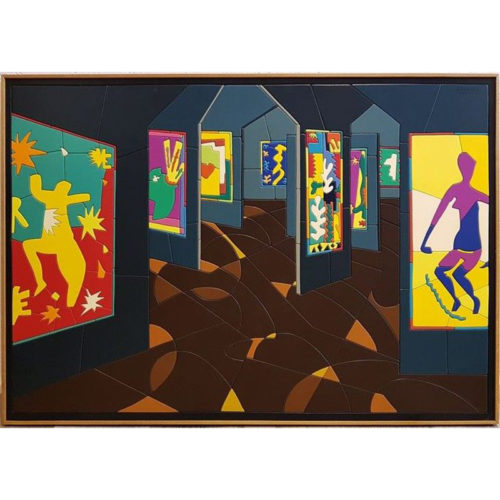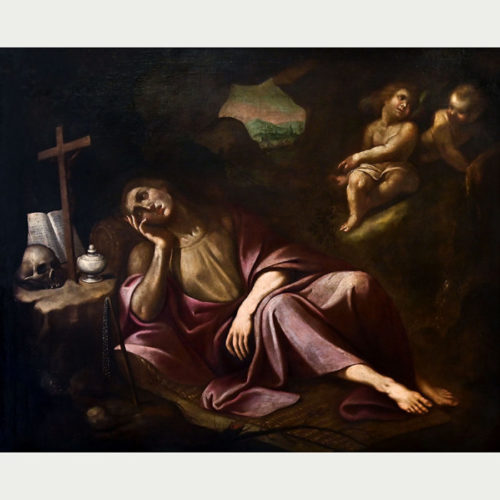-
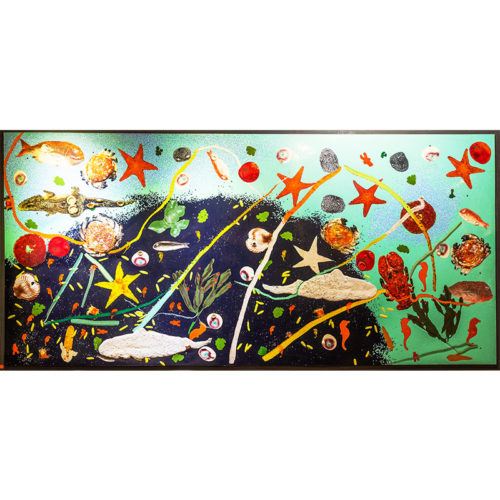 The most important work of Omar Aprile Ronda (Portula, 11 September 1947 - Biella, 7 December 2017), was an Italian artist, painter, sculptor, art collector and publisher. The work is published on the cover of the catalog "Genetic Fusions - Genetic Fusions" of 1991 of which a quote is reported below: "Genetic Fusions" are fascinating for their relation with the infinitely small, within which thousands of events take place and where order seems to be the highest law we are not allowed to know yet, but that the artist makes us perceive through imagination and poetry" The work is dated and signed on the back by the author who guarantees its authenticity. Period: 1990 Measurements: H 135 x L 281 cm
The most important work of Omar Aprile Ronda (Portula, 11 September 1947 - Biella, 7 December 2017), was an Italian artist, painter, sculptor, art collector and publisher. The work is published on the cover of the catalog "Genetic Fusions - Genetic Fusions" of 1991 of which a quote is reported below: "Genetic Fusions" are fascinating for their relation with the infinitely small, within which thousands of events take place and where order seems to be the highest law we are not allowed to know yet, but that the artist makes us perceive through imagination and poetry" The work is dated and signed on the back by the author who guarantees its authenticity. Period: 1990 Measurements: H 135 x L 281 cm -
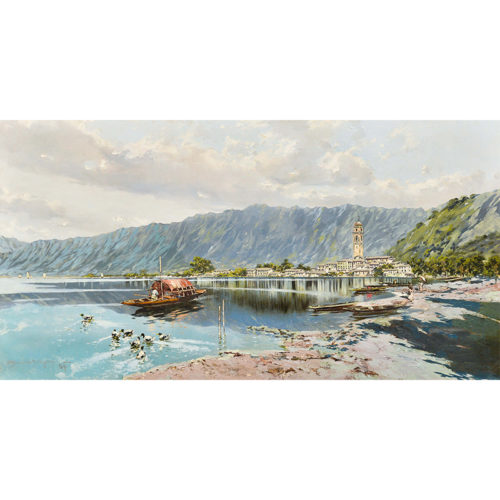 Period: 1896 Measurements: In frame H 87 x L 143 / Canvas H 65 x L 121 cm"Lago Maggiore" - Large oil painting on canvas by Riccardo Pellegrini (1863-1934), depicting a landscape on the shores of Lake Maggiore. Restored, with coeval frame. PELLEGRINI RICCARDO. Born in Milan on 11 March 1863, died in Crescenzago (Mi) on 31 March 1934. He studied in his city, then in Rome, and in Naples with Domenico Morelli. He travelled to Spain, England and France to deepen his artistic knowledge. In 1912 he won the Muller house competition in London for the illustrations of the Gil Blas of Le Sage. Then the illustrations for "Don Quixote" were commissioned. The main magazines in Europe collaborated with him. He rarely exhibited in Italy, but when he did it had always success. His sketch Malta is located in the Berlin Art Museum; La ridda, in the Gofort Museum in Stuttgart; The kiss of sun, in the Goupil Gallery in Paris. The drawings made for the "Gil Blas" were collected in a room dedicated to the Pilgrims in the Glasgow Museum. The Bottega di Poesia exhibition held in Milan in 1926 featured: A carpet market in Spain; Winter quiet; Sun of July; One August morning in Toledo; Valencian Sea; The spouses. Other works: Spanish flower market, in the R.O. collection of Rome, one of his best works; Villereccia party, in the Rovelli collection of Milan; The antiquarian, in the Ruffini collection in Milan; In the market (Xeres); Sur la promenade des Anglais; Notes of Spain; Remembrance of Seville; I remember my country; El picador; El primer espada; View of Seville; Spanish types; A bullfighter.
Period: 1896 Measurements: In frame H 87 x L 143 / Canvas H 65 x L 121 cm"Lago Maggiore" - Large oil painting on canvas by Riccardo Pellegrini (1863-1934), depicting a landscape on the shores of Lake Maggiore. Restored, with coeval frame. PELLEGRINI RICCARDO. Born in Milan on 11 March 1863, died in Crescenzago (Mi) on 31 March 1934. He studied in his city, then in Rome, and in Naples with Domenico Morelli. He travelled to Spain, England and France to deepen his artistic knowledge. In 1912 he won the Muller house competition in London for the illustrations of the Gil Blas of Le Sage. Then the illustrations for "Don Quixote" were commissioned. The main magazines in Europe collaborated with him. He rarely exhibited in Italy, but when he did it had always success. His sketch Malta is located in the Berlin Art Museum; La ridda, in the Gofort Museum in Stuttgart; The kiss of sun, in the Goupil Gallery in Paris. The drawings made for the "Gil Blas" were collected in a room dedicated to the Pilgrims in the Glasgow Museum. The Bottega di Poesia exhibition held in Milan in 1926 featured: A carpet market in Spain; Winter quiet; Sun of July; One August morning in Toledo; Valencian Sea; The spouses. Other works: Spanish flower market, in the R.O. collection of Rome, one of his best works; Villereccia party, in the Rovelli collection of Milan; The antiquarian, in the Ruffini collection in Milan; In the market (Xeres); Sur la promenade des Anglais; Notes of Spain; Remembrance of Seville; I remember my country; El picador; El primer espada; View of Seville; Spanish types; A bullfighter. -
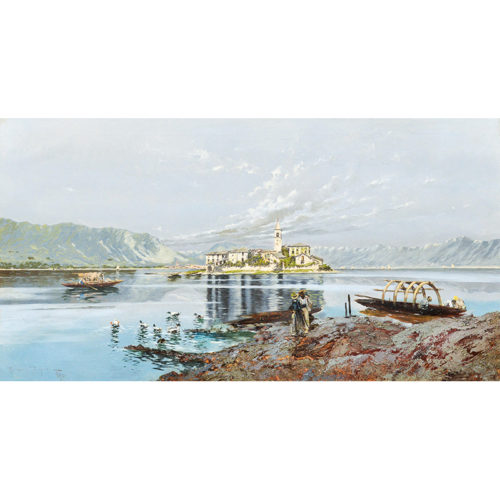 Period: 1896 Measurements: In frame H 87 x L 143 / Canvas H 65 x L 121 cm"Lake Maggiore" - Large oil painting on canvas by Riccardo Pellegrini (1863-1934), depicting the Fishermen's Island seen from a coast. Restored, with contemporary frames. PELLEGRINI RICCARDO. Born in Milan on 11 March 1863, died in Crescenzago (Mi) on 31 March 1934. He studied in his city, then in Rome, and in Naples with Domenico Morelli. He travelled to Spain, England and France to deepen his artistic knowledge. In 1912 he won the Muller house competition in London for the illustrations of the Gil Blas of Le Sage. Then the illustrations for "Don Quixote" were commissioned. The main magazines in Europe collaborated with him. He rarely exhibited in Italy, but always with success. His sketch Malta is located in the Berlin Art Museum; La ridda, in the Gofort Museum in Stuttgart; The kiss of sun, in the Goupil Gallery in Paris. The drawings made for the "Gil Blas" were collected in a room dedicated to the Pilgrims in the Glasgow Museum. The Bottega di Poesia exhibition held in Milan in 1926 featured: A carpet market in Spain; Winter quiet; Sun of July; One August morning in Toledo; Valencian Sea; The spouses. Other works: Spanish flower market, in the R.O. collection of Rome, one of his best works; Villereccia party, in the Rovelli collection of Milan; The antiquarian, in the Ruffini collection in Milan; In the market (Xeres); Sur la promenade des Anglais; Notes of Spain; Remembrance of Seville; I remember my country; El picador; El primer espada; View of Seville; Spanish types; A bullfighter.
Period: 1896 Measurements: In frame H 87 x L 143 / Canvas H 65 x L 121 cm"Lake Maggiore" - Large oil painting on canvas by Riccardo Pellegrini (1863-1934), depicting the Fishermen's Island seen from a coast. Restored, with contemporary frames. PELLEGRINI RICCARDO. Born in Milan on 11 March 1863, died in Crescenzago (Mi) on 31 March 1934. He studied in his city, then in Rome, and in Naples with Domenico Morelli. He travelled to Spain, England and France to deepen his artistic knowledge. In 1912 he won the Muller house competition in London for the illustrations of the Gil Blas of Le Sage. Then the illustrations for "Don Quixote" were commissioned. The main magazines in Europe collaborated with him. He rarely exhibited in Italy, but always with success. His sketch Malta is located in the Berlin Art Museum; La ridda, in the Gofort Museum in Stuttgart; The kiss of sun, in the Goupil Gallery in Paris. The drawings made for the "Gil Blas" were collected in a room dedicated to the Pilgrims in the Glasgow Museum. The Bottega di Poesia exhibition held in Milan in 1926 featured: A carpet market in Spain; Winter quiet; Sun of July; One August morning in Toledo; Valencian Sea; The spouses. Other works: Spanish flower market, in the R.O. collection of Rome, one of his best works; Villereccia party, in the Rovelli collection of Milan; The antiquarian, in the Ruffini collection in Milan; In the market (Xeres); Sur la promenade des Anglais; Notes of Spain; Remembrance of Seville; I remember my country; El picador; El primer espada; View of Seville; Spanish types; A bullfighter. -
Out of stock
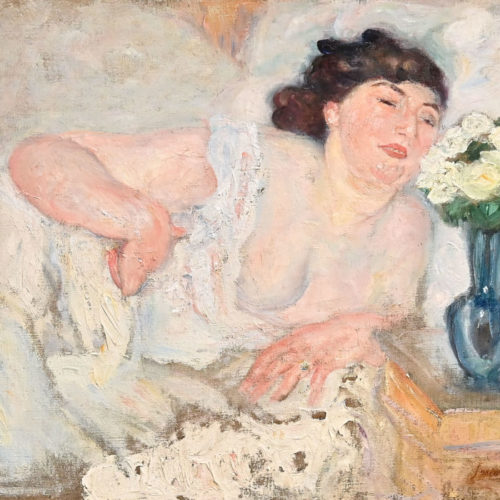 "Woman lying with blue vase" by Armando Spadini, oil on canvas signed on the lower right and dated 1902 on the back. The painting, although in excellent condition, needs cleaning. Armando Spadini (Poggio Caiano 1883 - Rome 1925) studied at the Institute of Fine Arts in Florence for a short time, visiting museums and exhibitions on his own, and assimilating, with his sensitivity, the joyfullness of colours, which is expressed personally, but not too far from the Venetian and French painters. Precisely this great love for the festive colours, for the transparent clarity, for the solar luminosity is showed in all his works, without the tormenting research that often characterized the work of the Impressionists. He is a painter superior to his time, to his environment; Emilio Cecchi considers him, like Antonio Mancini, the strongest pictorial temperament that arose in Italy after the end of the 18th century. Having won the competition for national retirement for painting in Florence in 1910, he settled in Rome, where he remained until his death, keeping on painting. He participated, but not so often, in various Roman and Florentine exhibitions, and in 1918 he held a solo show at the Casina Valadier in Rome. In 1924 at the Venice Biennale he had a room, where only his works had been displayed. Many of his works are in public and private galleries in Italy, in Paris, in Buenos Aires, in Lima. At the VI Quadriennale in Rome, in 1952, a commemorative exhibition took place with eighteen works. His works were also present at the 1956 edition of the same event. Period: 1902 Measurements: In frame H 80 x W 94 x D 12 / Canvas H 53.5 x W 70.5 cm
"Woman lying with blue vase" by Armando Spadini, oil on canvas signed on the lower right and dated 1902 on the back. The painting, although in excellent condition, needs cleaning. Armando Spadini (Poggio Caiano 1883 - Rome 1925) studied at the Institute of Fine Arts in Florence for a short time, visiting museums and exhibitions on his own, and assimilating, with his sensitivity, the joyfullness of colours, which is expressed personally, but not too far from the Venetian and French painters. Precisely this great love for the festive colours, for the transparent clarity, for the solar luminosity is showed in all his works, without the tormenting research that often characterized the work of the Impressionists. He is a painter superior to his time, to his environment; Emilio Cecchi considers him, like Antonio Mancini, the strongest pictorial temperament that arose in Italy after the end of the 18th century. Having won the competition for national retirement for painting in Florence in 1910, he settled in Rome, where he remained until his death, keeping on painting. He participated, but not so often, in various Roman and Florentine exhibitions, and in 1918 he held a solo show at the Casina Valadier in Rome. In 1924 at the Venice Biennale he had a room, where only his works had been displayed. Many of his works are in public and private galleries in Italy, in Paris, in Buenos Aires, in Lima. At the VI Quadriennale in Rome, in 1952, a commemorative exhibition took place with eighteen works. His works were also present at the 1956 edition of the same event. Period: 1902 Measurements: In frame H 80 x W 94 x D 12 / Canvas H 53.5 x W 70.5 cm -
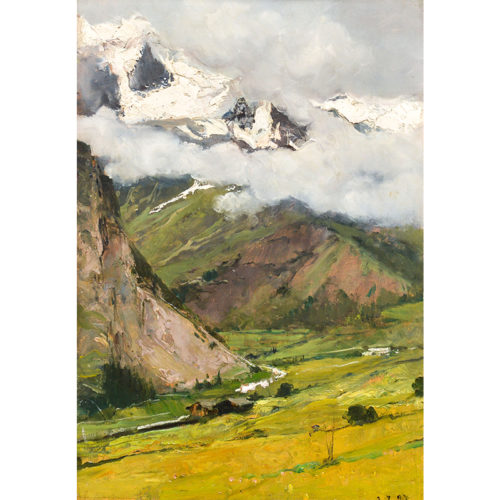 "Mountain landscape, Aosta Valley" - Oil on tablet by Lorenzo Delleani, dated lower right 3.7.97, on the authentic back of Bistolfi. Authenticated by the Piedmontese figurative painters and sculptors archive. DELLEANI LORENZO. Born in Pollone (Biella) on 17 January 1840, died in Turin on 13 November 1908. He studied at the Albertina Academy, a pupil of Gamba for drawing, then of Carlo Arienti and Andrea Gastaldi, graduating in 1862 when he had already made his debut as Promoter of Fine Arts in 1855 and established itself in 1860 with an episode of the siege of Ancona. According to the romantic interests of his time, he initially dedicated himself to painting of historical re-enactment, to achieve more spontaneous research on the truth with interior studies, environment and views of Genoa, Venice and the surroundings of Turin, as well as Pollone and Paris. At the national exhibition in Turin in 1880 the Ministry of Grace and Justice purchased the vast canvas Caterina Grimani Dogaressa, while critics showed that they preferred In the garden. The following year, in Milan, alongside Sebastiano Veniero who presented the prisoners of Lepanto, he exhibited Quies, who earned him numerous acclaim, such as to induce him to abandon historical subjects to devote himself to the landscape, establishing himself for his genuineness and brightness. In addition to the large canvases destined for numerous national and international exhibitions, in which he participated in Italy and abroad, Delleani linked his name to a vast pictorial production made almost exclusively on small panels, "among the most convincing things in the Italian landscape of that age » (Lavagnino). Among his disciples we mention: Giuseppe Bozzalla, Sofia of Bricherasio, Giuseppe Buscaglione, Luigi Cantò, Giuseppe A. Levis, Angela Meucci, Camilla Bergonzio, Emilia Ferrettini Rossotti, Enrico Reycend. Delleani was in Paris and Bern in 1878, in Holland in 1883, Switzerland in 1892, but for his paintings he aimed above all at the reasons that nature and the environment could suggest to him during his periodic stays in the Biella area, in Venice, in Rome, on the Riviera , in the Monferrato. Period: 07/07/97 Measures: In frame H 67 x L 53 x P 6.5 / Table H 45 x L 31 cm
"Mountain landscape, Aosta Valley" - Oil on tablet by Lorenzo Delleani, dated lower right 3.7.97, on the authentic back of Bistolfi. Authenticated by the Piedmontese figurative painters and sculptors archive. DELLEANI LORENZO. Born in Pollone (Biella) on 17 January 1840, died in Turin on 13 November 1908. He studied at the Albertina Academy, a pupil of Gamba for drawing, then of Carlo Arienti and Andrea Gastaldi, graduating in 1862 when he had already made his debut as Promoter of Fine Arts in 1855 and established itself in 1860 with an episode of the siege of Ancona. According to the romantic interests of his time, he initially dedicated himself to painting of historical re-enactment, to achieve more spontaneous research on the truth with interior studies, environment and views of Genoa, Venice and the surroundings of Turin, as well as Pollone and Paris. At the national exhibition in Turin in 1880 the Ministry of Grace and Justice purchased the vast canvas Caterina Grimani Dogaressa, while critics showed that they preferred In the garden. The following year, in Milan, alongside Sebastiano Veniero who presented the prisoners of Lepanto, he exhibited Quies, who earned him numerous acclaim, such as to induce him to abandon historical subjects to devote himself to the landscape, establishing himself for his genuineness and brightness. In addition to the large canvases destined for numerous national and international exhibitions, in which he participated in Italy and abroad, Delleani linked his name to a vast pictorial production made almost exclusively on small panels, "among the most convincing things in the Italian landscape of that age » (Lavagnino). Among his disciples we mention: Giuseppe Bozzalla, Sofia of Bricherasio, Giuseppe Buscaglione, Luigi Cantò, Giuseppe A. Levis, Angela Meucci, Camilla Bergonzio, Emilia Ferrettini Rossotti, Enrico Reycend. Delleani was in Paris and Bern in 1878, in Holland in 1883, Switzerland in 1892, but for his paintings he aimed above all at the reasons that nature and the environment could suggest to him during his periodic stays in the Biella area, in Venice, in Rome, on the Riviera , in the Monferrato. Period: 07/07/97 Measures: In frame H 67 x L 53 x P 6.5 / Table H 45 x L 31 cm
